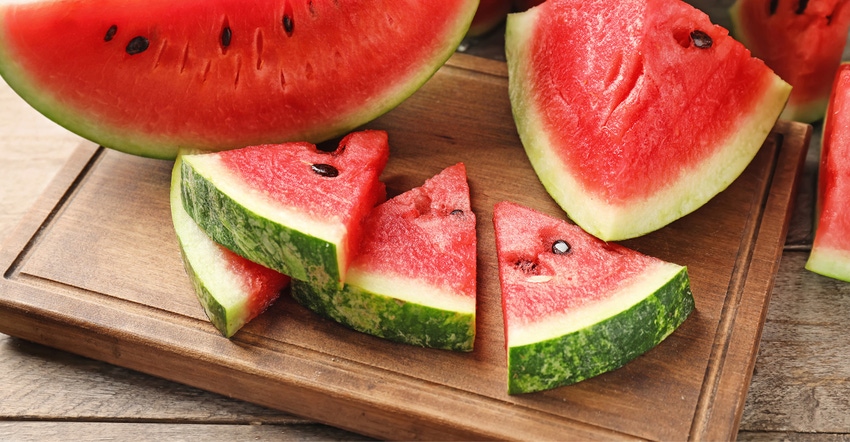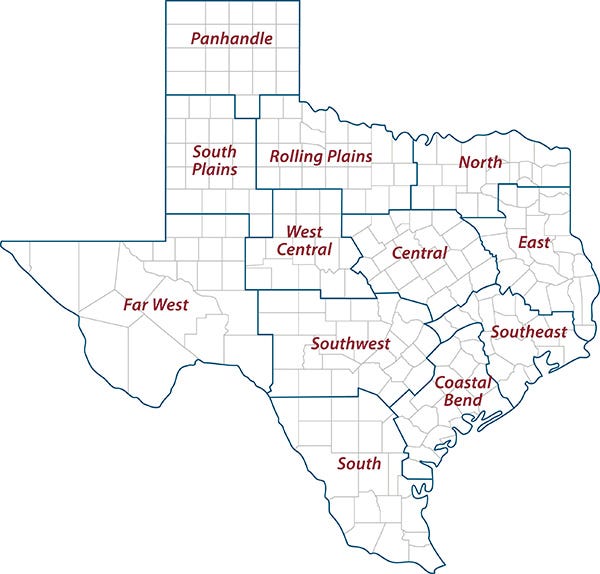
Texas’ watermelon growers in the Rio Grande Valley are getting excellent prices and producing high- quality fruit amid low supplies, according to a Texas A&M AgriLife Extension Service expert.
Juan Anciso, AgriLife Extension vegetable specialist, Weslaco, said watermelons in the Rio Grande Valley were getting to market later than usual, but that quality and prices are setting the stage for a good 2020 season.
Watermelons there were two weeks behind schedule, Anciso said. He suspects the spread of viral disease via white flies in hoop house crops, which were planted earlier than traditional watermelons, slowed their progress.
Harvesting of watermelons under hoop tunnels was supposed to begin April 1 but didn’t begin until April 15, he said. By that time, watermelons grown by traditional method in open fields had caught up and were ready for harvest.
“We didn’t have colder-than-normal weather, so the only thing to explain the crop being behind schedule is the spread of a virus in the earlier-planted crop,” he said.
The quality of watermelons, especially their brix counts, which measures sweetness, has been high, Anciso said. Brix measurements of 10 are standard and considered “sweet,” where measurements of 11 are “very sweet.”
“The melons I’ve cut in the field and at home have had brix counts between 11 and 13, which is off the charts,” he said. “So, quality is way up. It’s one of the best seasons as far as quality that I have seen.”
High quality creates more questions regarding the delayed maturity, he said. Typically, a viral disease stress will hurt quality and yield if those plants survive.
Yields were down, he said, but farmers were reporting adequate amounts per vine to make 2020 a good year at market.
Watermelon prices up
High prices could help watermelon growers in the Rio Grande Valley make up for losses during a bad 2019, he said. Last year, wholesale watermelon prices were 14 to16 cents per pound, and farmers incurred losses of $1,000 per acre on average.
This year, wholesale prices have been steady at 24 to 25 cents per pound, he said.
“We were worried about COVID-19 affecting watermelons because it is a ‘social’ fruit, but these prices could help producers make up for last year,” he said.
Anciso attributed the high prices to low supplies due to below normal production in Mexico and Florida. Mexico had serious production problems, he said, and very few watermelons were being exported to the U.S.
The delay could allow Rio Grande Valley watermelons – which are typically going to market in April and May – to ride the wave of even higher watermelon prices around the Fourth of July holiday week.
“The delay may actually allow some producers to capitalize on the Fourth of July window that historically is the best time to market watermelons,” he said. “Despite all the question marks surrounding this season and why watermelons performed the way they did, we expect growers to report a strong season.”
AgriLife Extension district reporters compiled the following summaries:

CENTRAL
Storms delivered rain and heavy hail, including golf ball-sized and softball-sized hail, that damaged some crops, homes, businesses and vehicles. Counties reported trace amounts to 3.5 inches of rain. Some damaged corn had already pollinated and still might do OK. Other fields will be lost. Approximately 2,500 acres of corn and about 200 acres of wheat were destroyed. The cattle market improved a bit, and sheep and goat markets were good. Pasture and hay conditions looked good and were getting better. Wheat harvest was in full swing, and yields were about average to a little above average. Soil moisture conditions improved. Crops were progressing rapidly. Cotton fields were reaching the square stage.
ROLLING PLAINS
A few areas in the district received beneficial rains. Cotton producers continued to plant crops. Wheat harvest continued. Some areas reported flourishing native grasses and Bermuda grass pastures while other ranchers were providing supplemental feed and mineral for cattle due to poor grazing conditions.
COASTAL BEND
Rainy conditions continued and limited fieldwork to aerial application of common and Southern corn rust. Crops responded quickly to rainfall over the last few weeks. Yield potential for the corn crop had already been lowered due to the extended dry period since planting. Grain sorghum was expected to benefit from the rain more than the corn crop. Sorghum was heading out and turning red in some areas. The cotton crop was helped by rains and expected to improve yields. Rangeland and pasture conditions continued to improve. Some hay was being harvested as weather allowed, but most producers were waiting for drier conditions. Cattle were in good condition with adequate forage.
EAST
Rainfall continued to help forages and crops. Hay production was in full swing. Producers were cutting hay between rains. Vegetable crops looked good. Blackberry, plum and blueberry harvests began. Pasture and rangeland conditions were good. Subsoil and topsoil conditions were adequate. Producers were controlling weeds in pastures and along fence lines. Reports of external parasite issues in cattle and horses continued to be a problem in Houston County. Wild pig damage was a major problem in crops, pastures and even residential areas. Cattle markets were stronger in some counties. Livestock were in fair to good condition.
SOUTH PLAINS
Dry conditions continued. Many farmers finished planting dryland cotton. Irrigated cotton was starting to emerge, and some dryland fields were emerging. Wheat harvest was in full swing. Irrigated corn was in good condition.
PANHANDLE
Northern parts of the district reported short to adequate moisture levels, while central areas reported very short soil moisture. Southern areas reported short soil moisture. Winter wheat, pasture and rangeland conditions were mostly fair to good. Some areas reported poor pasture and rangeland conditions. Corn was in fair to good condition. Wheat was maturing fast amid hot, dry conditions.
NORTH
Topsoil moisture levels were mostly adequate with some reports of both surplus and short moisture. Rainfall ranged from 1-3 inches. Daytime temperatures passed 90 degrees. Bermuda and Bahia grass were thriving due to warmer nighttime temperatures. Hay harvest continued, and some producers were working on their second cuttings already. Rangeland and pasture conditions were good. Stock tank levels were good. Winds were drying out topsoil. Insect pests were causing stress on livestock.
FAR WEST
High temperatures were above 100 degrees with lows in the mid-50s. Rain amounts averaged 1 inch. Small grass fires were reported daily. Crops without irrigation were suffering from moisture stress. Pastures had no grass and very few weeds. Irrigation was having a hard time keeping up with corn fields’ demand, and dryland sorghum was suffering during the heat of the day. Dryland cotton was not expected to emerge without rain. Dryland farmers dry-planted in the hopes of rain. Irrigated cotton looked decent but was growing slow. Oats were cut for forage. Producers were harvesting wheat. Pecan nut casebearers were being monitored, and producers were ready to spray. Livestock producers continued to rotate cattle on pastures. Producers were turning out bulls for the breeding season. Producers continued to provide supplemental feed to livestock and wildlife.
WEST CENTRAL
Spotty showers were reported. Some areas received over 2 inches of rain while others reported sprinkles. Some cotton will need replanting while some producers were waiting for soil to dry for planting. Rain helped grain sorghum and corn. Storms caused some damage to corn and sorghum. Wheat harvest slowed due to the rains. Rains helped pastures green up. Livestock were in fair to good condition.
SOUTHEAST
Growing conditions were good to excellent. Some hail was reported during thunderstorm events but caused minimal agricultural damages. Pasture and rangeland conditions were poor to excellent, and cattle and other livestock were in good condition. Soil moisture levels ranged from adequate to surplus.
SOUTHWEST
Rains across the district delivered traces of moisture up to 3.3 inches. Some locations reported hail. Pasture and rangeland conditions were fair and improved in areas that received moisture. Oat and wheat harvests were finished with average to good yields being reported. Livestock were in fair to good condition. Lamb and kid goats were growing and doing well. The sheep and goat market was holding steady. Caldwell County reported slight price increases for good bulls, cows and feeder cattle at market. Wildlife conditions were good.
SOUTH
Northern and western parts of the district reported mild weather conditions with adequate soil moisture levels while eastern and southern areas reported mild weather and very short to adequate soil moisture levels. Daily temperatures were above 100 degrees in a few areas. Scattered rainfall fell in several counties, including 2 inches of rain in parts of La Salle County, 4 inches in Maverick County and 3-4.5 inches of rain in Zapata County. Webb County reported surplus soil moisture levels. Jim Wells County reported receiving up to 8 inches of rainfall during the past two reporting periods. Growing conditions were good and improving in many areas. Many reported stock tanks were filled. Moisture should also help forage producers. Potato harvest continued, and wheat harvest was completed. Corn was in the silking stage, and cotton was in the squaring stage. Peanut planting continued. Pasture and rangeland conditions continued to improve with recent rainfall. Very little supplemental feeding of livestock was reported. Coastal Bermuda grass fields were producing good hay bales, and other crops like cantaloupes and watermelons were in good condition. Dryland sorghum, corn and cotton improved in areas that received moisture. Onion harvest was halted due to wet conditions but was expected to resume quickly. Later-planted row crops showed resiliency and have some yield potential now. Beef cattle prices were still low.
Read more about:
WatermelonAbout the Author(s)
You May Also Like




